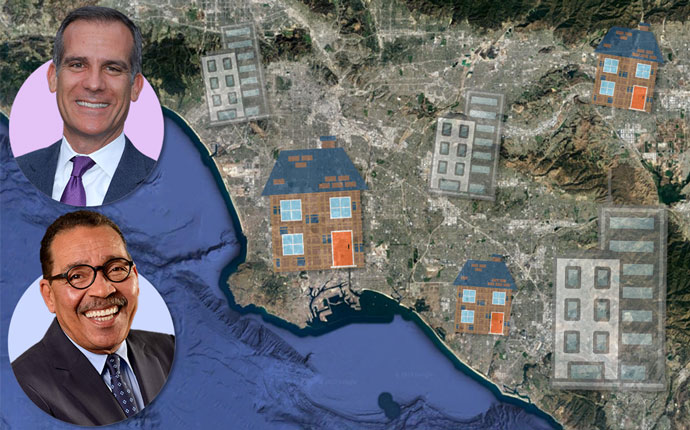Trending
 City Council approves zoning change to greenlight casinos
City Council approves zoning change to greenlight casinos “Investing before the ‘all clear’ sign”: Jon Gray on Blackstone’s $10B apartment deal
“Investing before the ‘all clear’ sign”: Jon Gray on Blackstone’s $10B apartment deal Rent board’s 4% hike will “plunge” buildings into distress: landlords
Rent board’s 4% hike will “plunge” buildings into distress: landlords Evictions surge at Hialeah’s luxury apartment projects Shoma Village, Pura Vida and Manor
Evictions surge at Hialeah’s luxury apartment projects Shoma Village, Pura Vida and ManorDespite housing crisis, LA lags in building on its own sprawling land portfolio
A decentralized system has bogged down construction projects and much of the city-owned land is unfit for development, experts say

When Los Angeles City Council President Herb Wesson proposed building an emergency homeless shelter in a city-owned parking lot in Koreatown last year, residents and businesses fearful of a homeless population expanding in their neighborhood began organizing against it.
Equipped with megaphones and picket signs, opponents of the proposal — the first of its kind under Mayor Eric Garcetti’s “A Bridge Home” program — took to the streets to protest the proposed shelter. Some went so far as to threaten a recall for Wesson, who represents the area.
“We thought we had done that before, but it was obvious that we did not do enough talking,” Wesson said.
Faced with mounting criticism, Wesson rescinded his proposal and said he would analyze other sites nearby, also owned by the city. At the same time, city officials in other pockets of the county were in the process of identifying city sites in their own districts for shelters in Hollywood, Los Feliz, Venice, among others.
Under Garcetti’s “Bridge Home” program, announced last year, the city would provide funds for each council district to build at least one temporary shelter. Each shelter would offer several months of housing to about 100 homeless people as case workers look for more permanent housing for them. In exchange, the neighborhood would receive intensified city cleaning services.
As the $77 million initiative has shown, Los Angeles owns a massive real estate portfolio —about 8,900 parcels in the county— that stretches from the Santa Monica coast to the rolling hills of the San Fernando Valley. But efforts to develop on the city’s vacant land have been slow moving, compounding the region’s affordability and homeless problem.
“The real general theme here is that there’s no centralized process for [developing city-owned] real estate,” said Michael Kelly, executive director of the Los Angeles Coalition for the Economy & Jobs. “There are so many economic development tools, but the city doesn’t have a development strategy. There’s really no one in charge.”
For Wesson, the first step was picking a site that was owned by the city. His office then conducted a preliminary report to see how challenging it would be to build something on the site. Once it was established that the site was big enough, or had the proper terrain, the city then started analyzing construction plans for the site.
“It made sense to try to use as much city property as we could because, [since] we own the land, we could fast-track things that we might need to have happen on the land,” Wesson said.
Last April, Garcetti declared a “shelter crisis” in L.A. that allowed him, and the city, to take advantage of a new state law, AB 932. Under the law, approved in late 2017, cities are allowed to build homeless shelters on any land that’s owned or leased by the city. At the same time, Garcetti also signed a Permanent Supportive Housing Ordinance into law that removed much of the red tape, shrinking the development timeline for shelters from as many as five years to less than one.
But fast-tracking capabilities haven’t always worked as intended. In Venice, opponents of a proposed shelter sued the City of L.A. and the Coastal Commission in January for failing to properly analyze the full “adverse” effects of the shelter, as other projects have to do under the California Environmental Quality Act, or CEQA, and Coastal Commission Act. The 13-0 council vote in favor of the 154-bed shelter had exempted the $5 million project from an extensive review under CEQA laws, allowing construction to occur much quicker than normal. Earlier this month, an L.A. Superior Court judge ruled construction can start as the lawsuit plays out in court.
The city’s real estate empire
Los Angeles has been amassing real estate over the years in a variety of ways, such as foreclosures or for large city infrastructure projects that never came to fruition.
In 2015, the L.A. Coalition teamed up with Garcetti’s office to find out how much land the city owned. After 18 months of research, they concluded that Los Angeles owns a diversified portfolio of 9,000 parcels in California, with most of them based in the county. The value of that portfolio was also found to be $3 billion based on the latest 2014 Asset Management Services Study conducted by the city’s consultant.
Today, the valuation is bound to be much higher, Kelly added.
And figuring out how much of that terrain is buildable has proved to be more difficult than expected.
Last fall, city administrative officer (CAO) Richard Llewellyn Jr. released a report detailing some of those issues. Llewellyn’s office had been tasked in 2016 to analyze a list from the real estate division of the city’s Department of General Services (GSD), which had deemed 428 city-owned properties as “surplus” and thus available for sale. In some cases, the city could also solicit proposals for developers to buy and build on the surplus land for city purposes, such as affordable housing.
The CAO’s results were much less optimistic than those of the GSD. Out of the 428 surplus properties, only four fit into the “surplus” category as suitable for homeless housing. Another 152 properties had to be removed from the “surplus” list for a variety of reasons, including that “they should be retained by another department.” An additional 272 properties needed “further review” because they were either too small or they were potential single-family home sites.
“Most are too small to build on,” Llewellyn said. “We have tried to go through every single surplus property to determine which of those are buildable jewels that we are under-using. Our conclusion is that we are not.”
The GSD’s revised list of properties features 404 “undeclared surplus properties,” and only one surplus site.
Nearly 90 percent of the “undeclared” — properties not available for sale — are vacant, according to an analysis of the data by The Real Deal. They range from as small as 59 square feet to a 612,000-square-foot plot of dirt in Beverly Glen. The average square footage is around 25,000 square feet, and combined, they add up to 8.7 million square feet.
Llewellyn cautions that analyzing it from a square footage point of view would be an inaccurate way to measure the holdings, as many are hillsides and thus unsuitable for development. What’s more important, he claims, is what’s buildable.
But while the CAO’s office claims only a small number properties are suitable for development, housing advocates argue a lack of resources and decentralized system is more to blame than the terrain. The complaints aren’t limited to outside the doors of City Hall, either.
In 2003, then-City Controller Laura Chick released an audit and said that the city “does not manage its real estate assets well.” Five years later, she authored a report that said the GSD had failed to implement most of the recommendations, and called for “a citywide strategy, centralized database and the maximization of surplus property.”
Fast forward 11 years later, and a similar statement is being echoed by the current controller, Ron Galperin. Last year, Galperin told the Planning Report that, “the city owns so many properties that even if we did only a somewhat better job with just some of them, we’d be well ahead of where we are now.”
Galperin had recently launched Property Panel LA, an interactive map of all city-owned land. In a memo accompanying the release, he said “the City’s decentralized approach to its real estate has not served us well.” Adding, “notably, GSD lacks the staffing and the expertise needed to properly execute its mission.”
The website is no longer available to the public. A spokesperson for Galperin said it is because they are rolling out a second version, though they declined numerous attempts to comment for this article.
A slow build
Despite a number of hurdles, there has been some progress in affordable housing development.
After Garcetti’s office issued a request for proposals in 2016, Los Angeles entered into at least 35 contracts with affordable housing developers who plan to build low-income housing on city land. They are all in different stages of development, according to documents obtained by TRD.
A spokesperson for the city declined to confirm the number of affordable housing projects that are active.
While Los Angeles officials have been slow to build on the land, community activists have also taken matters into their own hands.
Free Lots Angeles, a partnership of several nonprofits, has been working to turn city-owned land into public parks, gardens or marketplaces. After five years, the organization managed to secure city council approval in 2018 for its Adopt-A-Lot program, paving the way for 10 city-owned lots to become productive community spaces.
In Koreatown, the community has now reversed course and thrown its support behind Wesson’s new proposal.
After the initial uproar over the homeless shelter site subsided, Wesson and Garcetti’s office decided they would build a 75-bed facility about a quarter-mile away on another city plot at the corner of Wilshire Boulevard and Hoover Street. With “probably about 99 percent of the community” in support, Wesson said the shelter is expected to open in a few months.
“[The] process of constructing living facilities is a long process, and there are various hoops that you have to go through,” he said. “I think it’s been challenging, but I don’t think it’s been impossible. Things are getting better.”
